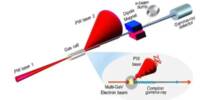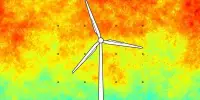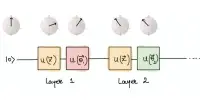Systems in which mechanical motion is controlled at the level of individual quanta are emerging as a possible quantum-technology platform. New experimental work now reveals how quantum features of such systems can be examined without disrupting the quantum state – an important step toward realizing the full potential of mechanical quantum systems.
When thinking about quantum mechanical systems, single photons, isolated ions and atoms, or electrons spreading through a crystal may come to mind. In the perspective of quantum mechanics, more exotic are genuinely mechanical quantum systems, which are enormous objects in which mechanical motion, such as vibration, is quantized. In a series of landmark investigations, essential quantum-mechanical properties such as energy quantization and entanglement were detected in mechanical systems. Observing quantum features, however, is only the first step toward using such systems in fundamental investigations and practical applications.
The next step is to master mechanical quantum object manipulation so that their quantum states can be manipulated, monitored, and eventually exploited in device-like structures. Yiwen Chu’s group at ETH Zurich’s Laboratory of Solid State Physics has now achieved significant progress in this approach. They report in Nature Physics that they were able to extract information from a mechanical quantum system without damaging the valuable quantum state. This breakthrough opens the door to applications such as quantum error correction and beyond.
Massive quantum mechanics
The ETH physicists use a slab of high-quality sapphire that is just under half a millimetre thick as their mechanical system. On top of the slab is a thin piezoelectrical transducer that can stimulate acoustic waves that are reflected at the bottom and so expand across a well-defined volume within the slab. These excitations are the aggregate motion of many atoms, but they are quantized (in energy units known as phonons) and can, in theory, be subjected to quantum operations in the same manner that atoms, photons, and electrons can.
Surprisingly, the mechanical resonator can be interfaced with other quantum systems, specifically superconducting qubits. The latter are tiny electronic circuits in which electromagnetic energy states are quantized, and they are now one of the main platforms for developing scalable quantum computers. The electromagnetic fields associated with the superconducting circuit allow the qubit to be coupled to the piezoelectrical transducer of the acoustic resonator, and therefore to its mechanical quantum states.
The finest of both worlds can be merged in hybrid qubit-resonator devices. Specifically, the highly developed computational capabilities of superconducting qubits can be exploited in conjunction with the robustness and extended duration of acoustical modes, which can act as quantum memory or transducers. However, linking qubit and resonator states will not suffice for such applications. For example, a simple measurement of the quantum state in the resonator destroys it, making subsequent measurements impossible. Instead, the capacity to retrieve information about the mechanical quantum state in a gentler, more regulated manner is required.

The non-destructive path
Chu’s doctorate students Uwe von Lüpke, Yu Yang, and Marius Bild, along with Branco Weiss fellow Matteo Fadel and semester project student Laurent Michaud, have now demonstrated a procedure for such so-called quantum non-demolition measurements. During the measurement, no direct energy exchange occurs between the superconducting qubit and the acoustic resonator in their experiments. Instead, the qubit’s properties are made to depend on the number of phonons in the acoustic resonator, with no need to directly ‘touch’ the mechanical quantum state — think of a theremin, a musical instrument whose pitch is determined by the position of the musician’s hand without making physical contact with the instrument.
It is extremely difficult to design a hybrid system in which the state of the resonator is reflected in the spectrum of the qubit. There are strict requirements for how long quantum states can be sustained in the qubit and the resonator before they fade away owing to flaws and external perturbations. The team’s aim was to extend the lives of both the qubit and the resonator quantum states. And they succeeded by making a series of modifications, such as carefully selecting the type of superconducting qubit utilized and enclosing the hybrid device in a superconducting aluminium chamber to provide strict electromagnetic shielding.
Quantum information on a need-to-know basis
The team was able to gently extract the phonon-number distribution in their acoustic resonator after stimulating it with varied amplitudes after successfully pushing their system into the desired operating domain (known as the’strong dispersive regime’). Furthermore, they demonstrated a method for determining whether the number of phonons in the resonator is even or odd in a single measurement (a so-called parity measurement) without understanding anything else about phonon distribution. Obtaining such unique knowledge is critical in a variety of quantum-technological applications. A change in parity, for example (a transition from an odd to an even number or vice versa), can indicate that a mistake has altered the quantum state and that it has to be corrected.
However, before such error-correction systems can be implemented, the hybrid system must be further refined, particularly to improve the fidelity of the operations. However, quantum error correction is not the only use in the horizon. There are numerous fascinating theoretical proposals in the scientific literature for quantum-information protocols as well as fundamental research that take advantage of the fact that acoustic quantum states exist in enormous objects. These, for example, offer unique opportunities for investigating the scope of quantum mechanics at the limit of huge systems and exploiting mechanical quantum systems as sensors.
















